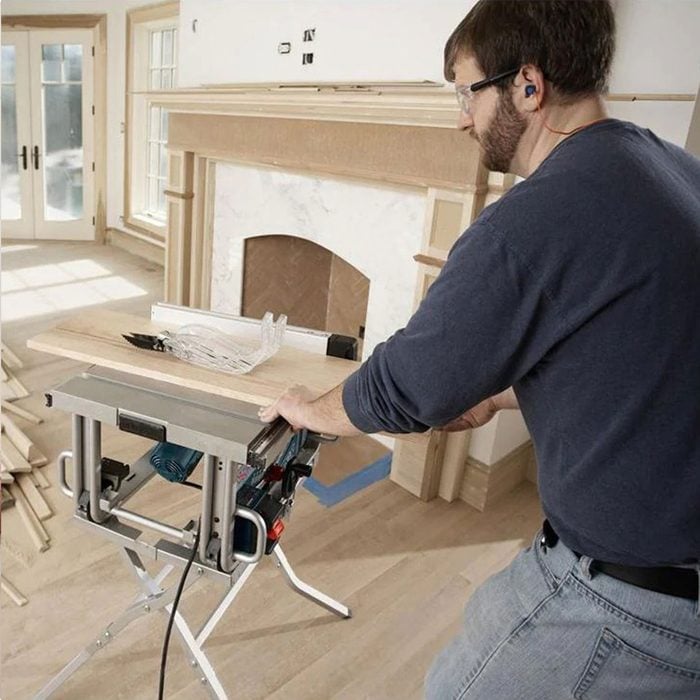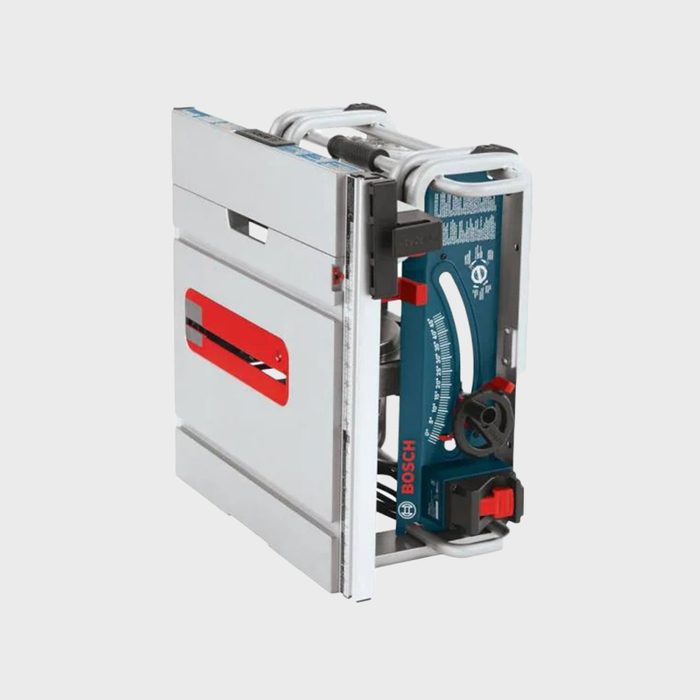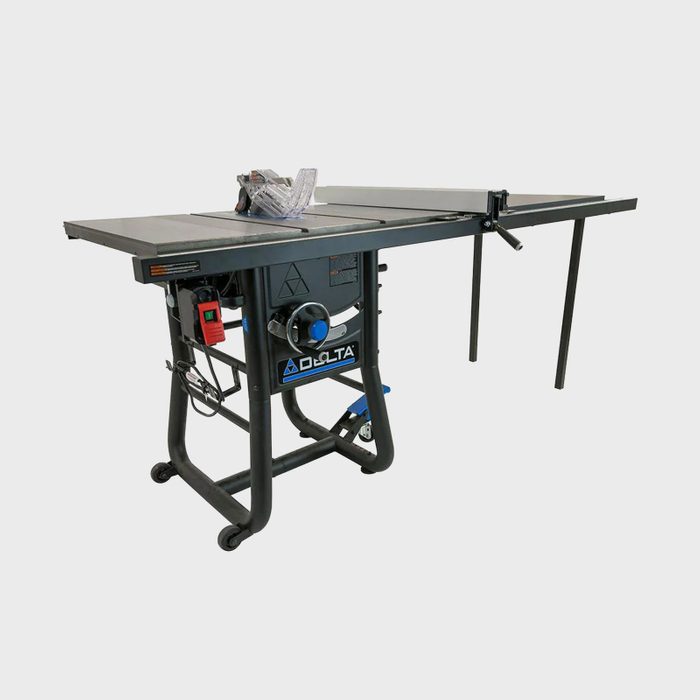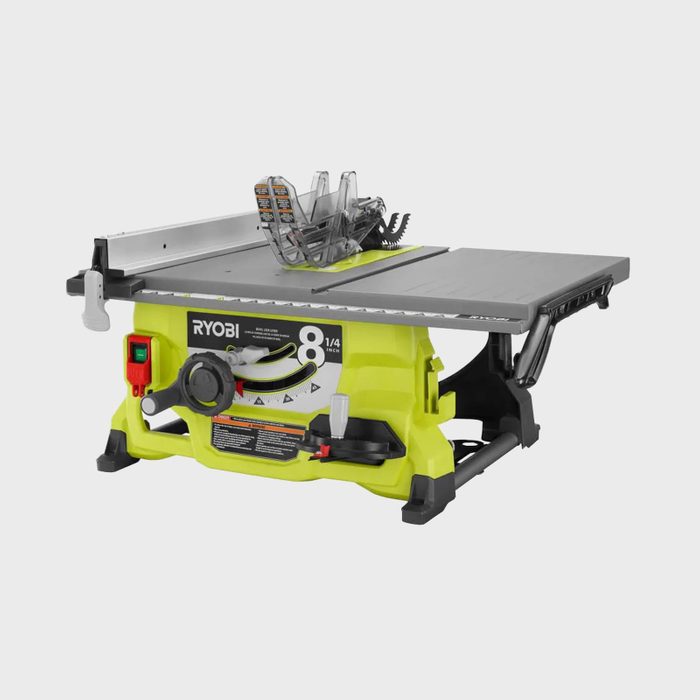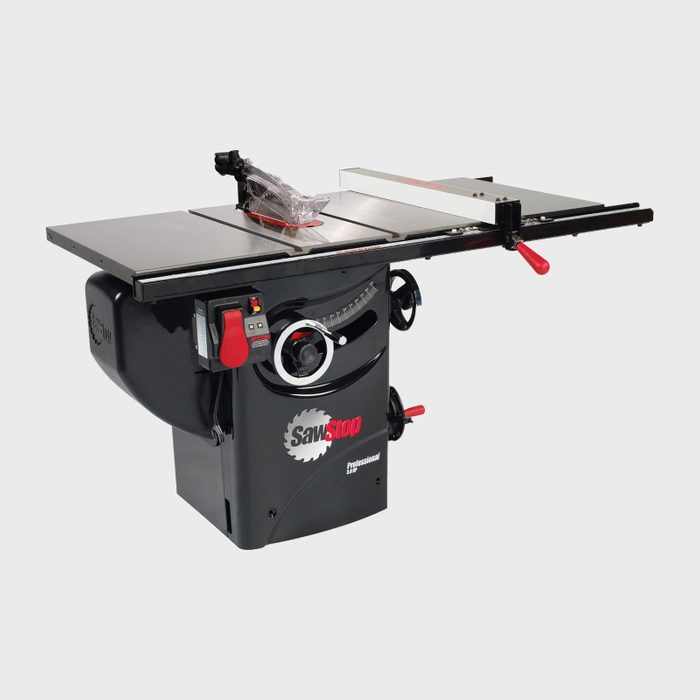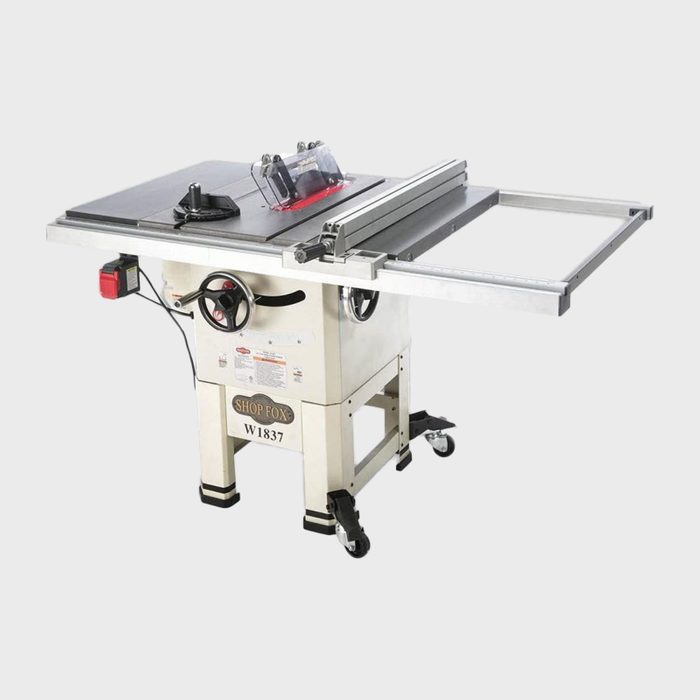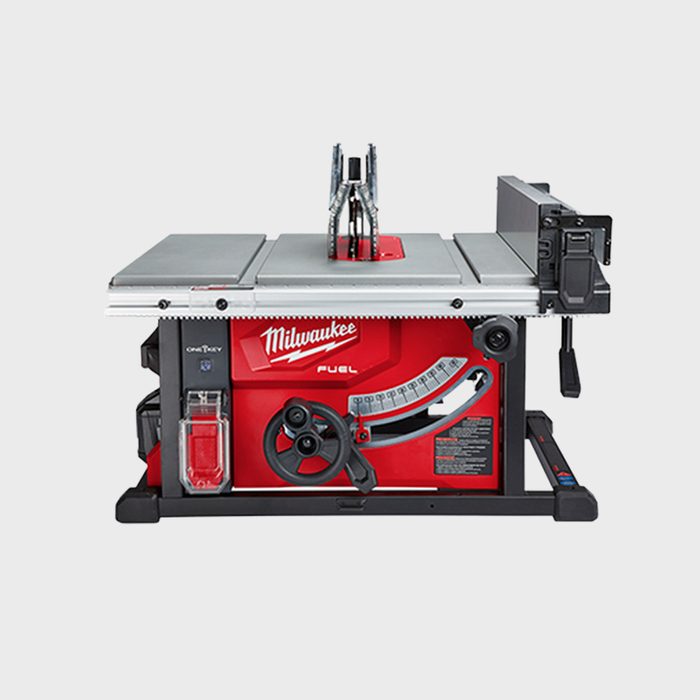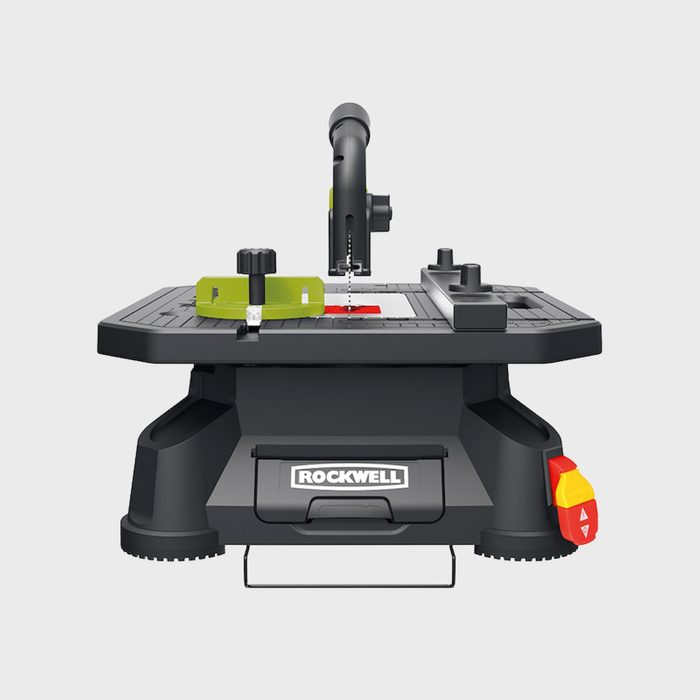 via lowes.com
via lowes.com
If you’re a woodworking hobbyist who makes small wooden goods and picture frames, you don’t need a full-size table saw. Enter the Rockwell BladeRunner RK7323, an ultralight benchtop saw that only weighs 15 lbs.!
With a 15-3/4-in. x 17-in. table, it can share your work table with other tools, and it fits easily in the car. The blade is only four inches in diameter, but the 5.5-amp motor develops enough cutting power for most small woodworking projects. The table, fence and dust port are comparable to those on larger models.
Product Specs:
- Type: Benchtop
- Power: 5.5 amps
- Size: 4 inches
- Rip Capacity: 4 inches
- Weight: 14 pounds
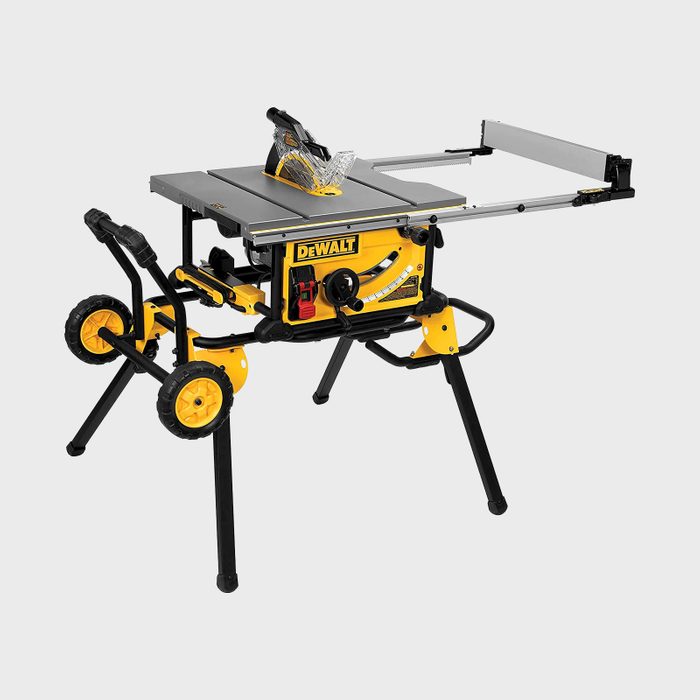 via lowes.com
via lowes.com
A good all-around table saw should be easy to transport but powerful and sturdy enough to use in the shop. You get all this and more with the 15-amp DeWalt 10-inch Contractor Table Saw.
Wheels let you roll it to the work site, the folding legs splay out at a wide angle for extra stability, and the table telescopes to 32-1/2-in. wide. The fence is so easy to deploy and so accurate that one Lowe’s web site reviewer wonders why the design hasn’t been copied by other manufacturers.
Product Specs:
- Type: Jobsite
- Power: 15 amps
- Size: 10 inches
- Rip Capacity: 32.5 inches
- Weight: 90 pounds
Types of Table Saws
- Benchtop: Benchtop saws are the smallest and easiest to carry around, and true to their name, can be set up on a workbench. They often come with removable stands.
- Contractor: Contractor saws are heavier, have bigger tables and provide more power. They are usually outfitted with wheels for easy maneuvering on construction sites.
- Cabinet: These are heavy-duty saws with a fully enclosed cabinet base, providing better dust collection and reduced noise. Cabinet saws are powerful and highly accurate, making them ideal for professional woodworkers and large-scale projects.
- Hybrid: Combining features of both contractor and cabinet saws, hybrid table saws aim to provide a balance between performance and affordability. They often have a closed base for improved dust control.
- Portable: “Portable saws are more convenient because they have a compact design and can be easily transported, which makes them ideal for job site work,” says Johnson. They may sacrifice some cutting capacity and stability though, which isn’t ideal for larger or more demanding projects.
- Stationary: These table saws have a more robust construction, which is ideal for a workshop environment, says Johnson. “Compared to portable models, stationary saws usually have more powerful motors, larger tables and more advanced features. If you prioritize performance and precision, a stationary table saw can provide better stability, cutting capacity and accuracy for heavy-duty woodworking tasks,” he explains.
What to Consider When Buying the Best Table Saw
- Power draw: Choosing the correct power is crucial, notes Johnson. “Look for a motor that packs enough punch to handle your cutting needs,” he says. Powerful motors draw between two and four amps of current, which can be enough to blow a breaker in your fuse box. Less powerful saws may not cut as cleanly or precisely but are fine for utility use.
- Weight: A convenient saw is lightweight and easy to transport, while an accurate saw is heavy enough to remain in place while you’re working. Look for a compromise that suits your needs.
- Stability: Contractor saws come with stands, and so do some benchtop models. The stand should be stable when placed on a flat surface and easy to set up. Avoid ones that wiggle.
- Fence: This must be sturdy and dead flat for accuracy. It should also be simple to adjust with an easy-to-read distance gauge and lock securely. “I’d say the fence is the most important thing to consider, whatever your budget is,” states Johnson. “But for those on a tighter budget, I would recommend choosing a table saw with a rack and pinion fence for a more reliable alignment.”
- Miter gauge: The miter gauge slides back and forth along the table top and lets you make angled crosscuts. It should have a secure locking clamp and a well-graduated angle scale that’s easy to read. It should also be sturdy.
- Blade size: “This really depends on what type of projects you’ll be tackling,” says Johnson. “Generally speaking, a 10-inch blade is enough for most woodworking tasks.”
- Blade adjustments: Table saws have a crank to set blade height, and the entire crank pivots to set blade angle. Both adjustments should be smooth (not sticky) and lock securely, and the angle scale should be easy to read.
- Price: Table saw prices vary, with entry-level models starting at around $200 to $500, contractor saws ranging from $500 to $1,000 and professional cabinet saws costing $1,000 or more. Hybrid models fall in between.
Why You Should Trust Us
With more than 30 years working in the building trades, I used my hands-on experience and first-hand knowledge to select the best table saw products on the market. I’ve contributed to constructing a city in the Oregon desert, co-established two landscaping companies and worked as a carpenter, plumber and furniture refinisher. Since 2010, I’ve been sharing my expertise through DIY articles and serving as an online consultant, including with Home Depot’s Pro Referral service. My practical insights have also been published on platforms like Landlordology, Apartments.com and Hunker, establishing me as a trusted source for reliable home improvement advice.
For this article, we also consulted Robert Johnson, a seasoned furniture maker and carpenter. Johnson is the founder of Sawinery Woodworking, a premier source for everything woodworking related. The site sells a curated collection of top-of-the-line power tools, offers woodworking classes for all skill levels, provides easy and advanced project plans and much more.
How We Found the Best Table Saws
To select the best table saws, we began by researching a wide range of models, considering factors such as blade size, motor power, cutting capacity and safety features. We then consulted with woodworking experts to understand the key considerations for hobbyists and professionals alike. After narrowing down our list, we analyzed user reviews to gauge real-world performance and reliability.
FAQ
What size table saw is best?
Choosing the best table saw depends on the scale of your woodworking projects and available workspace. For smaller projects, a compact table saw suffices; for larger projects, a contractor or cabinet model provides the necessary power and table space.
Johnson, who has extensive experience with various table saw sizes, notes that the most common size among owners is the 10-inch table saw. These models typically offer all the necessary features for most DIY and woodworking projects. They also handle standard-sized lumber and sheet goods effectively, he says. According to Johnson, this size strikes the right balance between portability and cutting capacity. “You can rip boards, crosscut lumber and make bevel cuts,” he explains, “and it’s also compact enough to fit in a home workshop or garage.”
How thick of wood can a table saw cut through?
According to Johnson, when it comes to cutting capacity, standard table saws can typically handle wood up to around three inches thick with a standard blade. “However, opting for a larger blade size, such as a 12-inch blade, extends this capacity to four inches thick. Keep in mind that when making lengthwise rips, the rip capacity of the table saw may become a limiting factor, especially with larger pieces of lumber,” he says.
What safety features should I look for in a table saw?
Important table saw safety features include a riving knife or splitter to prevent kickback, a blade guard for coverage during operation and anti-kickback pawls for added protection. A reliable blade brake system can rapidly stop the blade upon contact with skin. Additionally, an accessible emergency stop button and a user-friendly on/off switch are crucial.
How many teeth is best for a table saw?
The number of teeth on a table saw blade depends on the type of cuts you need for your woodworking projects. Blades with more teeth (40 or more) provide smoother finishes and are suitable for crosscuts and plywood. Blades with fewer teeth (24 to 30) are better for ripping through thick materials. A general-purpose blade with around 40 teeth can offer a balance between ripping and crosscutting capabilities, making it versatile for various tasks.





















